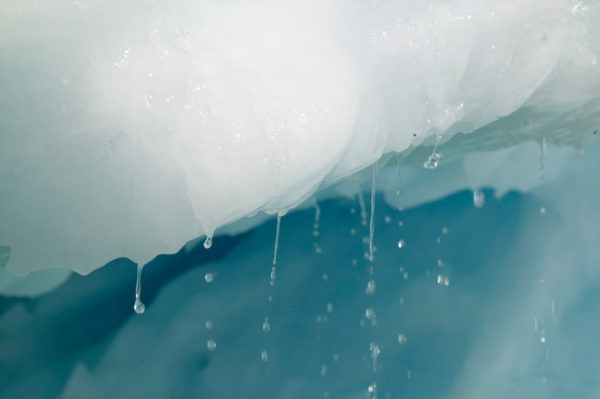What’s actually happening with the Arctic sea ice?
The Arctic is up to 20C warmer than usual for this time of year, and sea ice is at record lows. But it's not yet time to panic

You may have seen a number of terrifying graphs, stats and news headlines about the rapidly diminishing sea ice in the Arctic and Antarctic.
Yes, it is at a record low for this time of year.
Yes, greenhouse gases from burning fossil fuels is largely to blame.
And yes, the trends are *very* concerning.
Your daily reminder—until this makes front page news—that what’s happening right now at our planet’s poles is *not* normal. pic.twitter.com/1VK0BgcuS8
— Eric Holthaus (@EricHolthaus) November 19, 2016
It is, however, important not to get too carried away.
So Unearthed spoke to a couple of experts to dive into what’s actually going on.
Arctic
Two things are happening simultaneously. In the Arctic, the annual sea ice recovery isn’t yet happening — even though it normally starts weeks earlier than this.
There have also been days when the region’s sea ice extent has even fallen.
Meanwhile in the Antarctic, sea ice levels are falling faster than they ordinarily do at this time of year.
Both are significant, but mostly unrelated. Let’s start with the Arctic.
Visualization of #seaice from 9/19-11/19/2016. Outer lines indicate the average sea ice extent in the 1980/1990/2000s. Watch the Kara Sea: pic.twitter.com/xRqaCJFV0c
— Zack Labe (@ZLabe) November 20, 2016
According to Polar Oceanographer Dr Mark Brandon, “what’s happening is pretty much down to a lack of sea ice formation in the Kara Sea” — the body of water directly above Siberia.
That’s because the region is unseasonably warm, up to 20C hotter than it should be.
“But,” he said, “it’s actually really cold over northern Russia right now. And when that cold air finally reaches open water, it will freeze quickly.”
So it’s weather, as well as climate change. A confusing but important distinction.
“The region has, however, effectively missed a few weeks of sea ice growth so it will end up as thin ice, and that could lead to some surprises next year,” Brandon said.
What we are seeing right now is extreme weather. Very extreme
Julienne Stroeve, Professor of Polar Observation and Modelling at University College London, said many of the same things.
“What is happening is that there is both warm air that has been advected into the Arctic, and warm ocean,” she explained.
“These temperatures are prohibiting ice formation. That should change eventually, but it’s why the ice cover is so low at the moment.”
The Arctic heatwave, she said, could “give rise to a wavier jet stream with a higher probability of cold air spilling out of the Arctic into lower latitudes” — observing that Siberia and northern Europe are especially cold at the moment, and experiencing record snowfall.
Antarctic
“The Antarctic is also tracking unusually low,” Stroeve said.
“The processes driving these low conditions differs between poles, but it is something that we may eventually expect to see more frequently as the ozone hole recovers and Antarctica also starts to show sea ice loss.”
Brandon clarified that November almost always sees a “huge relative change in the Antarctic sea ice,” but it is happening faster and earlier than normal.
Let’s not forget that last year was a powerful El Nino, and there’s likely to be a knock-on effect from that.
“It’s an early spring”.
Different dynamics for #Antarctic sea ice and also currently its melt season… A look from 10/1-11/20 at its record low sea ice… pic.twitter.com/QV9c1CC0hI
— Zack Labe (@ZLabe) November 21, 2016
Climate change
Just what does this quite remarkable happening say about climate change? Is it happening faster than we thought?
Stroeve wouldn’t go that far, but did say that “the sea ice is generally retreating faster than the climate models forecast.”
She refers to a study published earlier this year, which “showed that the observed rate of summer ice loss is 3 square meters for every metric tonne of CO2.”
That’s significant because the average for climate models is about half that, at 1.75 square meters per metric tonne of CO2.
Essentially, it looks like scientists have largely underestimated the impact of carbon emissions on sea ice extent at the two poles.
Brandon meanwhile wouldn’t say that it’s all down climate change. He said: “What we are seeing right now is extreme weather. Very extreme.”
And, yes, that extreme weather is in part caused by climate change — but it doesn’t mean this will happen every year.
Citing climate scientist Ed Hawkins (he of the spiral graph), Brandon compared the trend of sea ice extent to “a bouncy ball going down a hill” — it’s definitely going down, but “sometimes it bounces higher and sometimes lower.”
For amazing Arctic infographics, follow Zack Labe

